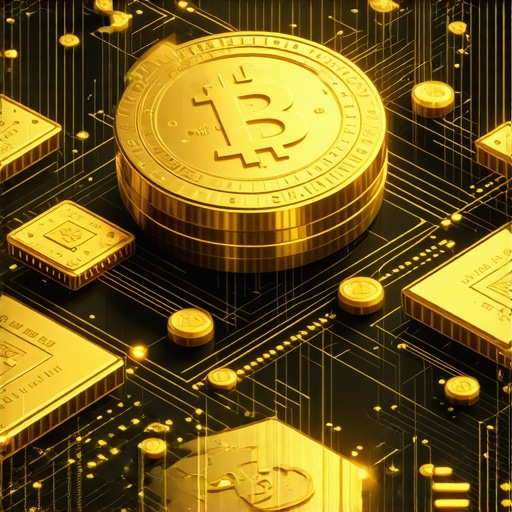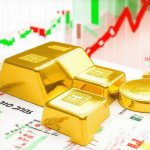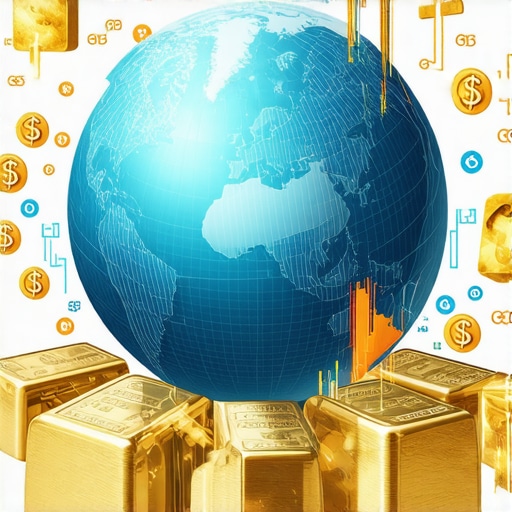Understanding the Nexus Between Global Economic Dynamics and Gold Price Fluctuations in 2025
As an expert in financial markets and precious metals, I recognize that the trajectory of gold prices over the coming year hinges intricately on macroeconomic indicators, geopolitical stability, and central bank policies. The year 2025 promises to be a pivotal period where evolving global economic trends could either bolster gold’s role as a safe haven or challenge its traditional valuation metrics.
The Impact of Macroeconomic Indicators on Gold Valuations
Key economic indicators such as inflation rates, GDP growth, and currency stability are primary drivers influencing gold prices. An environment characterized by persistent inflationary pressures often prompts investors to seek gold as a hedge, thereby elevating its value. Conversely, robust economic growth with reduced inflation expectations could diminish gold’s appeal, leading to potential price corrections.
Geopolitical Tensions and Their Role in Future Gold Demand
Geopolitical uncertainties, including regional conflicts and trade disputes, tend to increase demand for gold as a portfolio diversifier. The escalating tensions in certain regions could trigger a flight-to-safety among investors, pushing gold prices higher. Analyzing current geopolitical landscapes suggests that these tensions may persist or intensify, reinforcing gold’s safe-haven status in 2025.
Central Bank Gold Purchases and Their Market Implications
Central banks globally are increasingly engaging in gold accumulation strategies to diversify reserves and hedge against currency fluctuations. Notably, the recent surge in central bank gold purchases could significantly influence supply-demand dynamics, potentially driving prices upward. For comprehensive insights, see this analysis of central bank purchasing trends.
Will Inflation Remain the Dominant Force in 2025?
How will inflationary trends in major economies influence gold’s safe-haven appeal in 2025?
Inflation remains a critical factor. If inflation persists or accelerates, especially in economies like the US and the Eurozone, gold’s appeal as an inflation hedge could be reinforced. Conversely, successful monetary tightening or fiscal measures might temper inflation expectations, moderating gold demand.
Investors should consider diversifying their holdings by exploring long-term gold portfolio strategies tailored for these macroeconomic variables.
Expert Insights and Market Forecasts
Market analysts project that if inflationary pressures persist and geopolitical risks escalate, gold could see a notable rally in 2025. Conversely, a stabilizing global economy with diminishing uncertainties might lead to a plateau or slight correction in gold prices. Staying informed through authoritative sources such as the latest market analysis reports is crucial for strategic decision-making.
Engaging with professional insights and contributing your own analysis can enhance collective understanding. Consider exploring our expert tips on gold investment strategies to optimize your portfolio for 2025.
Decoding the Influence of Global Economic Shifts on Gold Price Trajectories in 2025
As an authority in precious metals markets, I understand that the future of gold prices is intricately linked to macroeconomic currents, geopolitical developments, and central bank policies. The year 2025 stands as a pivotal juncture where these elements could either enhance gold’s safe-haven status or challenge its valuation consistency.
How Do Inflation and Currency Fluctuations Drive Gold’s Market Dynamics?
Inflation rates and currency stability are vital indicators that impact gold demand. Persistent inflationary pressures, particularly in leading economies such as the US and Eurozone, tend to boost gold’s appeal as an inflation hedge. Conversely, a strong dollar or stable currencies can reduce gold’s attractiveness, potentially leading to price corrections. Investors keen on understanding these dynamics should explore our comprehensive analysis of gold demand drivers.
Could a shift in global monetary policies redefine gold’s role in diversified portfolios?
Indeed. As central banks adjust their monetary strategies in response to inflation and economic recovery signals, their gold reserve policies will influence supply-demand balances. An increase in gold purchases by central banks, driven by efforts to diversify reserves amidst currency fluctuations, could propel prices upward. For a strategic approach, consider reading long-term gold investment strategies for 2025.
Geopolitical Tensions: Catalyst or Obstacle for Gold’s Ascent?
Regional conflicts, trade disputes, and political unrest tend to elevate demand for safe-haven assets like gold. In 2025, ongoing geopolitical uncertainties could sustain or even amplify this trend, reinforcing gold’s position as a protective asset. Analyzing current geopolitical landscapes suggests that these tensions might persist or escalate, providing a foundation for sustained gold demand and potential price appreciation.
What Are the Implications of Emerging Economic Trends on Future Gold Valuations?
Emerging trends such as digital currencies, shifts in global trade patterns, and technological innovations could reshape the economic landscape. These factors might influence investor sentiment and the perception of gold’s utility in portfolio hedging. Staying abreast of market analysis reports will be crucial for making informed investment decisions.
Engaging with expert insights and keeping a close watch on macroeconomic indicators will empower investors to navigate the evolving landscape effectively. For actionable strategies, explore our guides on maximizing gold returns in 2025.
Innovative Perspectives on Central Bank Gold Reserves and Their Strategic Market Impact
Central banks are not merely passive holders of gold; they are active participants shaping the metal’s market trajectory through strategic reserve management. In 2025, their purchasing patterns are expected to reflect a sophisticated response to evolving geopolitical tensions, currency fluctuations, and inflationary pressures. Countries like China and Russia have been significantly increasing their gold reserves, signaling a shift towards diversifying reserve assets away from the US dollar and euro. This trend could lead to a sustained increase in gold demand, influencing prices in the long term. According to the International Monetary Fund’s recent report, central bank gold purchases are expected to reach unprecedented levels, potentially redefining supply-demand dynamics.
How do Central Bank Reserve Policies Shape Gold’s Role in Diversified Investment Portfolios?
Central banks’ strategic accumulation of gold acts as a hedge against geopolitical risk and currency devaluation, often influencing institutional investor sentiment. When central banks signal increased gold holdings, it tends to bolster gold’s safe-haven status among global investors. This dynamic underscores gold’s unique position as a non-sovereign, universally recognized store of value, especially amid volatile macroeconomic conditions. For investors looking to align their portfolios with these macro trends, understanding the nuances of central bank policies becomes essential. Explore our detailed guide to strategic gold allocation.
Emerging Technologies and Digital Assets: Future Catalysts for Gold’s Market Evolution
As blockchain technology and digital currencies gain prominence, gold is increasingly being integrated into digital asset platforms. Tokenized gold, which allows investors to buy fractions of physical gold through blockchain-based tokens, is revolutionizing liquidity and accessibility. In 2025, the proliferation of such instruments could significantly alter traditional gold investment paradigms. Platforms like CryptoGold and blockchain-backed gold platforms are paving the way for more transparent, secure, and fractionalized gold investments. This technological integration not only broadens investor access but also introduces new price discovery mechanisms, potentially influencing gold’s market volatility and valuation.
What Are the Risks and Rewards of Investing in Tokenized Gold?
Tokenized gold combines the stability of physical gold with the flexibility of digital trading, offering a compelling proposition for diversified portfolios. However, investors must consider regulatory uncertainties, cybersecurity risks, and the liquidity profiles of these digital assets. As the market matures, clearer regulatory frameworks are expected to emerge, providing greater investor protection and market stability. For a comprehensive understanding, see our analysis of tokenized gold investment risks and rewards.
Strategic Insights for Navigating 2025’s Gold Market Landscape
Given the multifaceted influences shaping gold prices—ranging from macroeconomic trends, geopolitical tensions, central bank strategies, to technological innovations—investors must adopt a dynamic, informed approach. Regularly consulting authoritative market analysis reports, such as the 2025 Gold Market Outlook, can provide critical insights. Integrating these insights with personalized risk assessments and long-term strategic planning will be vital for capitalizing on opportunities and mitigating risks in the evolving gold landscape.

Unveiling the Complex Interplay of Global Policy and Precious Metals
As we delve deeper into the nuances shaping gold’s trajectory in 2025, it becomes evident that the confluence of macroeconomic policies, geopolitical developments, and technological advancements forms an intricate web influencing investor sentiment and market dynamics. Central banks’ strategic maneuvers, especially in diversifying reserves through gold acquisitions, continue to be a pivotal factor, as highlighted by the International Monetary Fund’s recent report.
Can Innovations in Blockchain Transform Gold Investment Strategies?
The advent of tokenized gold and blockchain-based trading platforms introduces a paradigm shift, democratizing access and enhancing liquidity for investors worldwide. These technological innovations are poised to influence market volatility and price discovery, as exemplified by platforms like CryptoGold. However, they also bring regulatory and cybersecurity challenges that require vigilant risk management and strategic foresight.
What strategic adjustments should institutional investors consider amidst these technological shifts?
Institutional investors must integrate digital asset analysis into their traditional gold reserve management, leveraging insights from market analysis reports like the 2025 Gold Market Outlook. Such integration ensures resilience against emerging risks while capitalizing on technological efficiencies.
How Will Shifts in Consumer and Investor Behavior Shape Gold’s Future?
Demand patterns are evolving as digital currencies and alternative assets gain prominence. The increased interest in fractionalized gold through blockchain tokens signifies a move towards more personalized and accessible investment avenues. Understanding these behavioral shifts is crucial for predicting price movements and market stability in 2025.
Embedding Sustainability and Ethical Considerations into Gold Investment Strategies
With growing emphasis on environmental, social, and governance (ESG) factors, investors are increasingly scrutinizing the provenance and ecological impact of gold mining. Incorporating sustainability metrics into investment decisions not only aligns with global ethical standards but also influences market perceptions and demand dynamics. Resources like sustainable gold investment practices provide valuable guidance for responsible asset allocation.
Proactive Portfolio Management Amidst Evolving Market Paradigms
To navigate the complexities of the 2025 gold market landscape, investors should adopt a multidisciplinary approach combining macroeconomic analysis, technological foresight, behavioral insights, and ESG considerations. Continuous engagement with authoritative sources, such as the 2025 Gold Market Outlook, will empower strategic decision-making and risk mitigation. Embracing these comprehensive insights can position investors to leverage emerging opportunities effectively.

Expert Insights & Advanced Considerations
1. Diversification Beyond Traditional Gold Assets
As market dynamics evolve, integrating digital gold tokens and blockchain-based assets can provide diversification benefits and liquidity advantages, mitigating risks associated with physical gold holdings.
2. The Role of Geopolitical Stability in Market Volatility
Geopolitical tensions are likely to remain a significant driver of gold’s safe-haven demand. Monitoring regional conflicts and trade policies can offer predictive insights into short-term price movements.
3. Central Bank Policies as Market Catalysts
Central banks’ reserve management strategies, particularly in gold accumulation, continue to influence supply-demand equilibria. Analyzing their public statements and reserve reports can enhance strategic positioning.
4. Technological Innovations Reshaping Investment Strategies
Emerging platforms for fractionalized gold investments and tokenization are democratizing access and potentially increasing market volatility. Staying informed about regulatory developments is critical.
5. ESG Considerations in Investment Decisions
Environmental, social, and governance factors are increasingly impacting gold demand, especially from institutional investors prioritizing sustainable assets. Incorporating ESG metrics can refine portfolio strategies.
Curated Expert Resources
- IMF Global Gold Reserve Strategies Report: Offers comprehensive insights into central bank reserve trends and policy implications.
- Blockchain News on Tokenized Gold Platforms: Provides updates on technological advancements and market adoption in digital gold assets.
- Market Analysis Reports from Leading Financial Institutions: Delivers in-depth forecasts and macroeconomic analyses relevant to gold investors.
- ESG Gold Investment Guidelines: Guides sustainable investing practices and assesses the impact of ESG factors on gold demand.
- International Monetary Fund (IMF) Publications: Authoritative data and analysis on global monetary policies affecting gold markets.
Final Expert Perspective
Understanding the future of gold prices in 2025 demands a nuanced appreciation of macroeconomic shifts, technological innovations, and geopolitical developments. Integrating expert insights with authoritative resources empowers investors to navigate this complex landscape effectively. As global economic trends continue to shape gold’s role as a safe haven, maintaining a strategic, informed approach will be paramount. Engage actively with industry reports and contribute your insights to foster a deeper collective understanding. For those committed to excellence in gold investment, continuous learning and adaptability are your greatest assets—embrace these principles to secure your financial future in 2025 and beyond.










